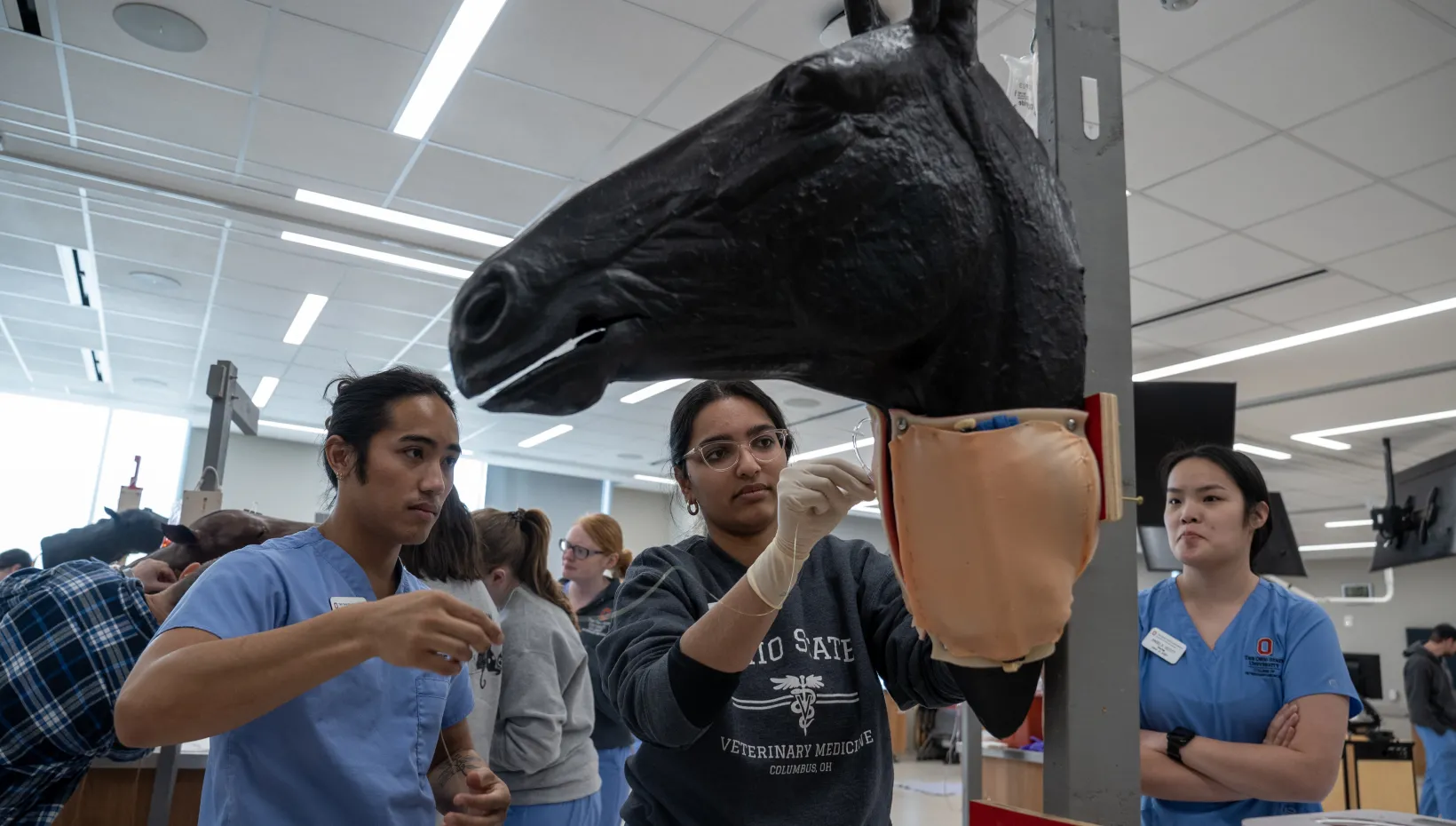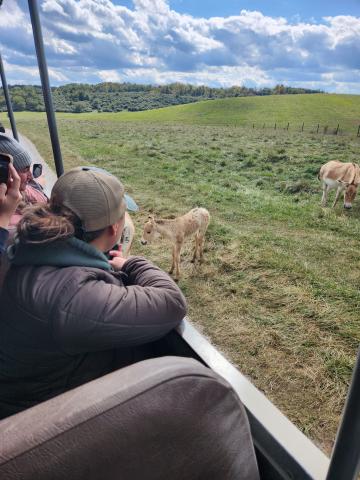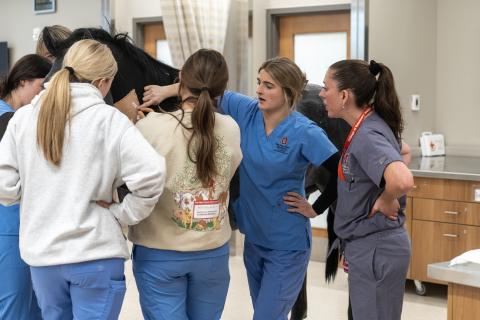Ongoing curriculum enhancements continue to transform student learning

Article by: Lisa Lopez-Snyder
Originally Published
Launched in the fall of 2022, The Ohio State University College of Veterinary Medicine’s new curriculum is designed to better integrate classroom learning with regular and recurring hands-on experience outside the classroom from veterinary students’ first day through the fourth year of their DVM program.
“We’re excited about this innovative, comprehensive educational approach,” says Rustin M. Moore, DVM, PhD, DACVS, Rita Jean Wolfe Endowed Dean, Ohio State’s College of Veterinary Medicine. “The curriculum’s clinical and didactic training aims to equip students with the necessary skills and knowledge to be competent and confident veterinarians who excel upon graduation.”
Faculty curriculum leaders say the new curriculum is already showing positive results inside and outside the classroom.
Early applied learning takes off
The early hands-on learning design is a significant change from the previous “legacy” curriculum in several ways, says Emma Read, DVM, MVSC, DACVS, associate dean for professional programs and the Ruth Stanton Chair, who led coordinating faculty teams in the new curriculum design.
“The legacy curriculum had very little — maybe five percent of the credit hours — oriented towards hands-on training in the first two years, with only a small amount of communications training,” she says. “Now, students have about 25% of their pre-clinical years focused on skills training."
Students used to take courses like anatomy, cardiology, respiratory and microbiology separately. However, within the new curriculum, related content is integrated and combined into larger courses, so students learn didactic knowledge and immediately apply it to clinical cases, talk about patients and problem-solve, Read adds. Each course builds on and uses knowledge and skills previously learned in a spiral manner.
Students increasingly engage, collaborate

Under the new curriculum, Read says that students are much more engaged in their pre-clinical years than they were in the past because of their regular connection to animals during this phase of the program. In the first year, for example, students have formal roles in the Frank Stanton Veterinary Spectrum of Care Clinic, where they observe and learn from the fourth-year students who work “as doctors” with patients and clients.
The new Healthy Populations course also exposes first-year students to a diverse range of veterinary work locations, including opportunities featuring large animals.
“Now, when students enter clinical skills and work with animals, they are reminded of their passion for veterinary medicine,” Read says. “While the program remains challenging, students appear more engaged and happier throughout their journey.”
Jeanette O’Quin, DVM, MPH, DACVPM, DABVP, associate professor-clinical in the Department of Veterinary Preventive Medicine, agrees. She says that the integration of the related courses appears to improve students’ understanding of learned concepts.
A faculty member who was part of the original curriculum design team from the program’s initial discussion phase through its implementation, O’Quin says the team’s efforts to incorporate more experiential learning opportunities are making a noticeable impact, even in the classroom.
In the preventive medicine portion, for instance, students take one or two field trips each semester to observe populations they are studying and their environments. Additionally, they engage in classroom activities that allow them to apply their newly acquired knowledge, she adds.
For example, when the class focuses on the principles of occupational health and safety, students learn how to identify and mitigate potential risks.
“We then break into small groups and each group is given a different scenario,” O’Quin says. “One group audits the risks on a swine farm, identifies mitigation strategies for each risk, and then determines what is and isn’t realistic to implement in that farm situation.”
O’Quin says these activities lead to more productive student discussions, both in and out of class, by enhancing learning and knowledge synthesis. “There seems to be a deeper understanding of these concepts.”
Supporting student learning

The new curriculum enables faculty to identify when students need help with their study habits sooner, says Alison Gardner, DVM, MS, DACVS-LA, DACVECC-LA CVA, associate professor, clinical skills educator and co-course leader of the Investigating Disease and Diagnosis course in year two of the new curriculum.
“We have a lot of students coming from different undergraduate and graduate experiences who may not have the same study tools entering veterinary school,” she says. To address this, Gardner says she’s working with the college’s Office of Teaching and Learning and other faculty to develop assessment objectives that are tailored to identify what students need to work on during their pre-clinical year.
The assessments also help students in preparing for the North American Veterinary Licensing Exam (NAVLE®). In this way, Gardner says, students “can target areas they didn’t achieve competency in, rather than feel overwhelmed with three years’ worth of material. We don’t want our students to feel lost or unsupported if they’re struggling.”
Read notes that the new curriculum redesign has also helped faculty become better teachers. Because they are leading the class in other ways rather than simply lecturing, it encourages them to be more focused on integrating the course material across subjects and species, she says.
O’Quin adds that the curriculum redesign has also fostered greater collaboration among faculty. “We are working in teams much more than before, especially having more interactions with those outside of our specialties,” she says.
“We’re more likely to reach out now to see what everyone else is doing, then complement and build on what’s already been taught.”
Realizing impact and outcomes
Faculty say they are already seeing the impact of the new curriculum on student competencies.
Gardner mentions that she is hearing from veterinarians who have hired Ohio State graduates that “our students have better hands-on skills.” She attributes this to the extensive assimilation of hands-on skills into their practice by the time they graduate.
“A couple of years ago, I’d have to walk students through step-by-step on how to place a nasogastric tube or a catheter in their final year,” she says. “Now, it’s just a matter of making adjustments for individuals already fairly competent in those skills. They can take more responsibility for their cases and focus more on the treatment plans and diagnostics because they already have those hands-on skills.”
The Class of 2026, who will be entering clinics in March, will be the first to experience the full scope of the new curriculum, O’Quin says. It’s an exciting time to see the impact of its development as they head into the final year, she adds.
“This effort has required immense coordination with our wonderful and productive faculty and clinical skills team,” O’Quin says.
The benefits are clear, she notes. “It’s showing us we’re producing graduates who not only know the ‘how’ but also understand the ‘why.’”
The new curriculum reflects the college’s commitment to advancing education and student success, furthering its ambition to Be The Model® comprehensive college of veterinary medicine in the world.